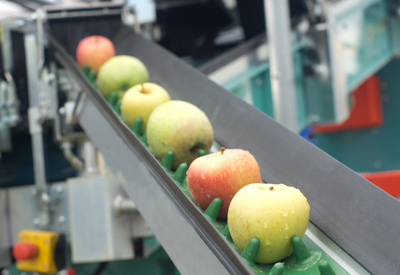Increasing Energy Efficiency in Food Processing Facilities
 Within Minnesota, there are more than 150 food processing facilities, which use an estimated 565 million kWh and 74 million therms annually. While there are specific energy conservation opportunities available for each type of facility, energy-saving upgrades to existing equipment or new equipment such as refrigeration, pump and fan systems, and combined heat and power could benefit most food processing facilities. Overall, research indicates that facilities could realize 10-15% energy savings by implementing new technologies.
Within Minnesota, there are more than 150 food processing facilities, which use an estimated 565 million kWh and 74 million therms annually. While there are specific energy conservation opportunities available for each type of facility, energy-saving upgrades to existing equipment or new equipment such as refrigeration, pump and fan systems, and combined heat and power could benefit most food processing facilities. Overall, research indicates that facilities could realize 10-15% energy savings by implementing new technologies.
Refrigeration
Refrigeration systems consume a large amount of electricity in food processing facilities. However, impressive savings have been achieved with refrigeration systems; some references quote savings as high as 30% of base electrical usage. Energy and cost savings can be obtained through a variety of modifications to the refrigeration system including improved insulation or tighter seals on doors. More complex changes to the system controls and variable frequency drives for the compressors or evaporator fans can also result in savings.
Pump and Fan Systems
Pumps and fans can account for up to 15% of the load in various facilities. Pumps are primarily used for cleaning operations and cooling, while fans are used for ventilation and cooling. When installed, pumps are often oversized to meet a maximum flow requirement; piping, valves, and the rest of the system may be undersized to contain costs. Fans are selected based on price and availability to provide a design air flow, not on energy and operating costs, and are also often oversized.
Both pumps and fans can be evaluated for energy saving opportunities. Pumping systems should be evaluated during the design phase and installation, though there may be retrofit opportunities available for large process pumps that run long hours as well as large cooling towers and HVAC systems. Fan speed should be evaluated; often, oversized fans can be slowed, resulting in a large decrease in energy consumption. Slower fan speed can also reduce fuel consumption. For example, slowing the fan speed can reduce the amount of make-up air needed to be generated.
Combined Heat and Power (CHP)
CHP provides an opportunity to reduce the overall energy consumption in facilities by generating electricity on-site and recovering waste heat from the electrical generation for the production process. When a facility obtains its electricity from the local utility and generates thermal energy through the combustion of natural gas, the energy conversion process is only 33% efficient. However, using CHP to produce electric energy on-site can result in 80% efficiency.
CHP processes convert waste heat or steam into electrical power. The food industry produces biomass waste, which could be used as an alternative fuel source. CHP, which requires a large capital investment, is an attractive opportunity for food processing facilities that have high energy intensity, a flat year-round load profile, and high thermal to electric ratios. Even facilities with an electrical demand less than 5 megawatts can benefit from CHP systems.
Resources
The following resources may help you start thinking about energy efficiency in your facility.
Compressed Air
- MnTAP Fact Sheet: Air Compressor Energy-Saving Tips (2009). This fact sheet about air compressors will help you calculate their operating cost, understand your system and identify easy to implement energy efficiency strategies.
- MnTAP Source Article: Listening for Leaks (pg6). MnTAP staff can help you find compressed air and steam trap leaks using an ultrasonic leak detector.
- Compressed Air Challenge Promotes energy and operational efficiency in compressed air systems for industry through information and training, leading end users to adopt efficient practices and technologies while leveraging collaborative cooperation among key stakeholders
- U.S. DOE Tool: AirMaster+ Software. This compressed air system assessment and analysis software package helps maximize the efficiency and performance of compressed air systems through improved operations and maintenance practices.
- U.S. DOE Tool: BestPractices for Compressed Air. Improving Compressed Air System Performance
Boilers and Steam Systems
- MnTAP Source Article: Energy Savings for Heating Water (pg4). One facility installed a direct heat system that is 99.7% efficient and capable of heating potable water within 20 seconds of starting while not requiring fuel for warm-up or idle time
- MnTAP Source Article: Boiler Efficiency (pg1). Inefficient and underused boilers were costing Schwan Food Company and Nordic Ware an excess amount in fuel.
- S. DOE Tool: BestPractices for Steam.
- Article: Inspect Steam Traps for Efficient System. Faulty or inoperative steam traps can cause losses of hundreds of thousands of dollars. This article explains how steam traps work and methods to monitor them.
Motors
- MnTAP Fact Sheet: Motor Energy Saving Tips (2009). This fact sheet will help you calculate your motor operating costs, develop a policy for motor repair and replacement and develop strategies to reduce energy used by motors at your facility.
- S. DOE Tool: Best Practices for Motors, Pumps and Fans.
- Source Newsletter Article: Variable frequency drives (pg4). VFDs on motors can enhance process operations, especially for flow control, and can efficiently cut energy demand for pumps and fans.
Lighting
- Program: Xcel Energy’s One-Stop program is available to businesses with an electric demand between 10-400 kW in Xcel Energy’s Minnesota service territory.